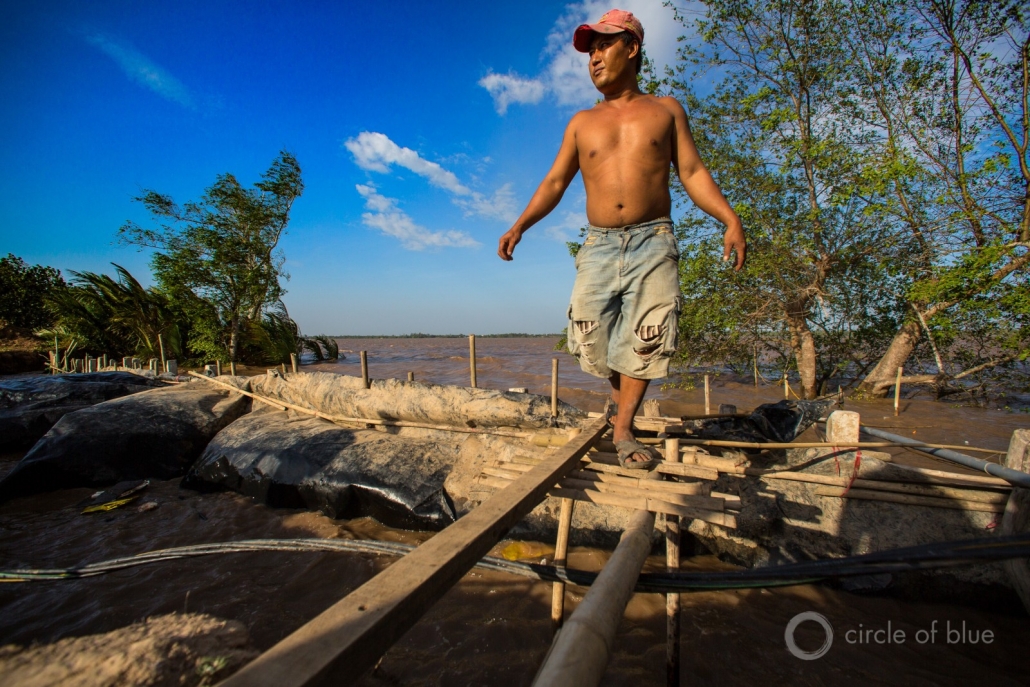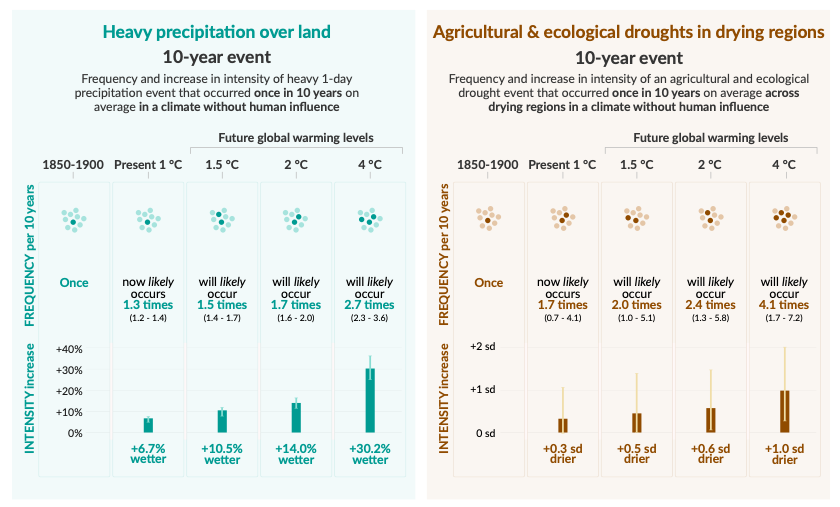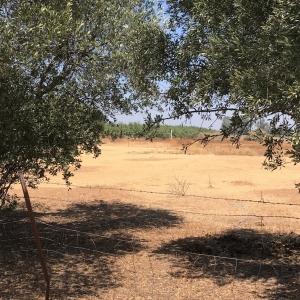The climate crisis will jeopardize key sources of fresh water and make extreme weather events more severe. But experts say there’s still time to prevent the worst outcomes.

A farmer in the Mekong Delta uses plastic, mud, and sticks to hold back the rising sea. According to the United Nations’ Intergovernmental Panel on Climate Change report published Monday, Southeast Asia coastal zones are among the world’s most climate vulnerable regions. Photo © J. Carl Ganter / Circle of Blue
- Extreme droughts affecting agriculture and ecosystems are already more frequent and intense than they were last century. This trend will continue as glacial melting, decreased rainfall, and a “thirstier” atmosphere jeopardize sources of freshwater in some parts of the globe.
- Heavy rainfall will also become more common and more powerful.
- There are a handful of high-impact “tipping points” that could drastically change global or regional water cycles. These events are unlikely in our current climate—but the warmer Earth gets, the bigger the risk becomes.
- With swift, drastic action, warming could still be limited to 1.5 or 2 degrees Celsius, avoiding the worst-case scenarios for freshwater.
By Laura Gersony, Circle of Blue — August 10, 2021
The Intergovernmental Panel on Climate Change, a group of the world’s leading climate scientists, released its sixth climate assessment on Monday. The 1,300-page paper is the most comprehensive, up-to-date report yet on the physical science of climate change, synthesizing the findings of thousands of recent publications.
The report paints an alarming picture of the future of fresh water. It concludes that man-made contributions to a warming planet are far-reaching. It finds more evidence that severe weather events are linked to carbon in the atmosphere and are becoming more extreme. And it shows that certain trends such as rising seas and shrinking ice sheets will continue even if carbon pollution were halted immediately. But it also indicates that by swiftly and drastically cutting greenhouse gas emissions, the worst effects of climate change can be prevented, avoiding worst-case outcomes for water availability.
“I used to say, when I was talking about climate change, that climate change is serious, certain, and soon,” said Linda Mearns, a senior scientist at the National Center for Atmospheric Research. “But this is no longer accurate. Now it is very serious, very certain, and now.”
Here are key takeaways from the report.
Extreme droughts affecting agriculture and ecosystems are already more frequent and intense than they were last century. This trend will continue as glacial melting, decreased rainfall, and a “thirstier” atmosphere jeopardize sources of freshwater in some parts of the globe.
The report makes a distinction between four types of droughts: those that affect precipitation, streams, farming, and ecosystems. It states with medium confidence that climate change is leading to an increase in droughts that impair agricultural production and ecosystems, due to the drying of soils.
Agricultural and ecological drought events that used to occur, on average, every 10 years are already 70 percent more frequent than they would be absent human influence. After 2 degrees Celsius of warming, which is the current trajectory unless emissions fall rapidly in the next few years, these events become 2.4 times as frequent. This is happening both because less rain is falling in drier areas, and because a warmer atmosphere is “thirstier” than in the past, evaporating more water out of soils. These changes are seen most clearly today, the report states, in western North America and the Mediterranean.
“If emissions continue, then there is a very good chance [for the western United States] that we’re going to see a level of drought and aridity that we haven’t seen in at least a thousand years,” said Jessica Tierney, an associate professor of geosciences at the University of Arizona.

A graphic from the report’s Summary for Policymakers illustrates that with every increment of temperature increase, extreme weather events become more frequent and more extreme. Graphic courtesy of the Intergovernmental Panel on Climate Change.
Another trend is that snowpacks and glaciers that many rely on for fresh water are disappearing. As winter months become warmer and the global mass of glaciers and snowpack shrinks, downstream regions will see less water in summer months.
Droughts are now worse mainly in dry areas, such as the Mediterranean basin, western North America, and southern Africa. But some wet regions, like the Caribbean and the Amazon, are expected to experience more severe droughts as well. These patterns are expected to further strain groundwater, which is already being depleted in many areas.
Heavy rainfall will become more common and more intense.
Atmospheric warming makes heavy rainfall even heavier: the warmer the atmosphere, the more moisture it can hold, which means more rain. Today, with atmospheric warming of just over 1 degree Celsius, 10-year rain events are 30 percent more frequent and 7 percent more intense than they would be absent human influence. The intensity and frequency of such storms increases with more warming.
With devastating floods already hitting worldwide — in July, towns in Germany’s Ahr Valley were destroyed by raging waters — it is clear that many cities are unprepared for storms of this magnitude. As temperatures climb, coastal cities are even more likely to see extreme flooding due to the combined effects of rising seas, extreme rain, and urban development.
Regional events such as the El Niño Southern Oscillation and monsoon rains are also expected to become more powerful over the course of this century.
There are a handful of high-impact “tipping points” that could drastically change global or regional water cycles. These events are unlikely in our current climate—but the warmer Earth gets, the bigger the risk becomes.
One tipping point scientists have on their radar is the Atlantic Meridional Oceanic Current, a stream of water running northward up the Atlantic whose flow depends on a precise temperature gradient. Warming ocean temperatures could cause this current to slow down or collapse altogether. The last time it collapsed — 12,000 years ago — it caused worldwide precipitation patterns to quickly intensify. While this is unlikely to occur before 2100, the current has already started to weaken.
Other tipping points include the sudden transition of the Sahara Desert into a wet climate zone and the Amazon Rainforest losing its ability to retain water due to deforestation. There is low confidence that either of these changes will occur before 2100, mostly due to limited evidence, but they become more likely as the planet’s temperature rises.
With swift, drastic action, warming could still be limited to 1.5 or 2 degrees Celsius, avoiding the worst-case scenarios for freshwater.
The report stated unequivocally, for the first time, that climate change is occurring due to “human influence,” namely the burning of fossil fuels and deforestation. Natural influences, such as volcanic activity or sunlight intensity, account for just a sliver of atmospheric warming.
But just as human behavior causes atmospheric warming, we can also prevent it. By quickly cutting greenhouse gas emissions, and reaching carbon neutrality by around 2050, it is still possible to limit warming to 2 degrees Celsius or even 1.5 degrees, the goal established in the Paris Climate Agreement. Those increments matter.
“Reducing emissions will reduce impacts,” wrote Mathew Barlow, a lead author on the report and a professor of climate science at the University of Massachusetts Lowell. “Every fraction of a degree matters.”
Laura Gersony covers water policy, infrastructure, and energy for Circle of Blue. She also writes FRESH, Circle of Blue’s biweekly digest of Great Lakes policy news, and HotSpots H2O, a monthly column about the regions and populations most at-risk for water-related hazards and conflict. She is an Environmental Studies and Political Science major at the University of Chicago and an avid Lake Michigan swimmer.





